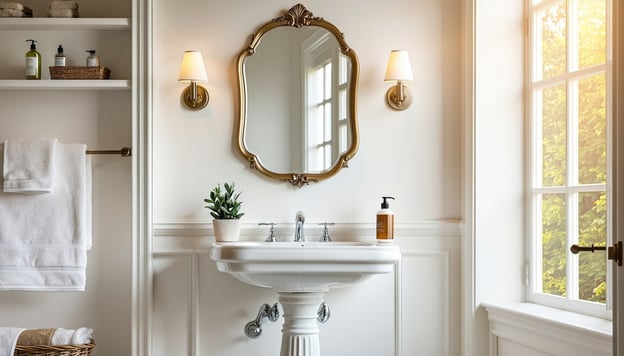Pedestal sinks have largely taken a backseat to larger, more functional vanities in many bathroom remodels these days, but they can be the ideal choice in the right situation. Here are some pedestal sink pros and cons if you’re considering a bathroom update.
Pedestal sinks were very popular in American homes in the early 20th century, when homes — and bathrooms — were smaller on average than they are today. Their utilitarian design and function featuring essentially just a sink basin and stand made them ideal for tight spaces.
In fact, those two pieces are really what make up a pedestal sink. The top basin includes the faucet attachments and the lower pedestal affixes the sink to the floor and helps hide the water supply and drainage pipes.
Pedestal sink pros
Great for smaller spaces
The compact size makes them ideal for cozier bathrooms, like half-baths or smaller master bathrooms. The more compact footprint allows for more room a larger shower or tub, os simply for more space to move around.
Classic style
Most pedestal sinks have a recognizable classic style that works well in a lot of Portland home styles, such as Craftsman, Bungalow, and Victorian type architecture. Those styles will lend themselves seamlessly to a bathroom remodel featuring a pedestal sink.
Cost
Given their smaller size compared to bathroom vanities as well as fewer components overall, pedestal sinks tend to be a cheaper sink option. They typically run just a few hundred dollars for the sink alone, depending on the type.
Easier to install
Generally, pedestal sinks are easier to update and install than larger vanities. They have fewer parts and hooking up plumbing lines is typically straightforward, assuming you have the right plumbing already in place and don’t need to move any water lines.
Pedestal sink cons
Minimal countertop
While pedestal sinks are great space-savers, their small size does have its limitations. One of them is counter area. Usually, they will come with enough counter space to hold your essential bathroom toiletries, but not much else. Often a medicine cabinet above the sink is added to allow for extra storage. So if counter space is important to you, you may want to reconsider a pedestal sink.
No below-sink storage
The countertop isn’t the only area where space is at a premium. The basic design of pedestal sinks mean they also lack any storage underneath. Whereas vanities typically include ample cabinet space, you’ll need to add other storage options with a pedestal sink.
Proportion
As we mentioned, pedestal sinks are great for smaller spaces, but if you’re tempted to opt for them in a larger master bath remodel, you’ll want to consider how they might look in proportion to the rest of the space. If the bathroom will include a large walk-in shower, grand spa tub, or an expansive wall mirror, one or two small pedestal sinks may appear dwarfed in comparison.
Visible plumbing
Though most pedestal sinks do come with a notch in the back of the pedestal to largely hide plumbing lines, those supply and draining lines can sometimes still be visible depending on the type of sink and how it is installed. That’s some thing to consider if keeping your plumbing hidden is important.
Pedestal or Vanity?
So, how do you decide whether to go for a pedestal or a vanity? It comes down to what’s most important to you in your bathroom space. If you need a lot of storage or counter area to house your bathroom items, then a vanity may be the better choice. Vanities typically offer ample space and can enhance the space in other ways, like with built-in lighting.

If you prefer a classic style and are remodeling a smaller space, a pedestal sink may be ideal. They can be more cost-effective, easier to install, and seamlessly complement a more traditional style home.




